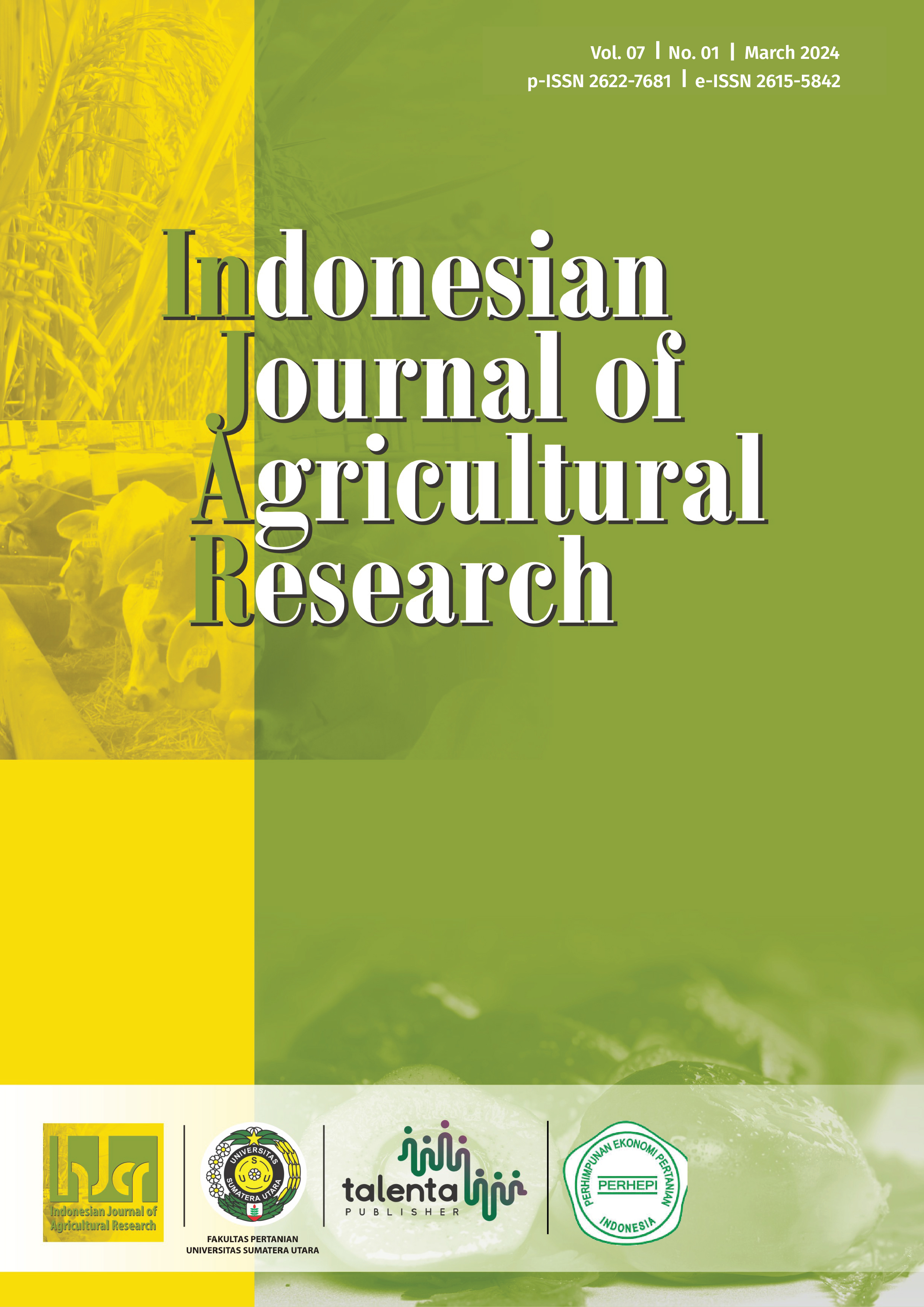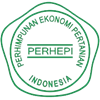Evaluating the Shelf Life of Chilled Raw and Pasteurized Goat Milk: An Analysis of Physicochemical and Microbial Content
DOI:
https://doi.org/10.32734/injar.v6i3.15241Keywords:
goat milk, microbial, pasteurized, Saanen, shelf lifeAbstract
Goat milk offers a variety of health benefits. The objective of this study is to evaluate the influence of refrigerated storage on the quality of unprocessed and pasteurized goat milk within a defined timeframe. In addition, also analyzes the chemical and microbiological composition of both raw and pasteurized goat milk during refrigerated storage to assess its longevity. Goat milk samples were obtained from healthy Saanen female goats, aged 3-4 years, with a body condition score (BCS) ranging from 2 to 3. The samples were taken from UniSZA Pasir Akar farm in Besut, Terengganu, Malaysia. The milk samples were processed through pasteurization. Exactly 10 goats were meticulously chosen, with each goat yielding 1 liter of milk. The goats were segregated into two cohorts: one cohort for raw milk (n=5) and the other for pasteurized milk (n=5). Subsequently, the milk samples from both groups were subjected to chilling storage experimentation at the food technology laboratory of Universiti Sultan Zainal Abidin (UniSZA) in Besut. The milk samples (duplicates) were monitored for 42 days to assess their physical characteristics. The pasteurized goat milk samples were evaluated for milk composition (fat, solid non-fat, protein, and lactose) and microbial contents (TPC and EMB) from Week 0 to Week 6. The effect of shelf life, composition values, and bacterial growth were measured weekly, and the data were presented descriptively (SEM±STD) with paired T-Test as the statistical analysis, considering p<0.15 as a significant difference. The findings revealed a downward trajectory in the physical attributes and chemical makeup of both unprocessed and pasteurized goat milk throughout the storage duration, resulting in decreases in fat, solid non-fat, protein, and lactose. The microbiological investigation revealed increased microbial levels in both raw and pasteurized milk after two weeks. Nevertheless, there was a subsequent decrease in the number of microorganisms from week 3 to week 6, indicating a phase of natural bacterial decline caused by limited nutrients and competition among bacteria. The study emphasizes the significance of maintaining sustainability in dairy production and addressing food safety concerns. It is crucial for customers to be informed about the duration of safe consumption of pasteurized milk and the potential threat of bacterial growth during prolonged cold storage
Downloads
References
P. Gerbault, A. Liebert, Y. Itan, A. Powell, M. Currat, J. Burger, D. M. Swallow, and M. G. Thomas, “Evolution of lactase persistence: an example of human niche construction,†Pho;psp[hica; Transactions of the Royal Society B: Biological Sciences, vol. 366, no. 1566, pp. 863-877, 2011, doi:10.1098/rstb.2010.0268.
C. Phosat, C. Phosat, C. Hudthagosol, P. P. Phienluphon, and K. Kwanbunjan, “The effect of goat’s milk consumption on the clinical health of middle-aged adults with lactose intolerance,†Malaysian Journal of Nutrition, vol. 28, 2022, doi:10.31246/mjn-2021-0087.
Y. Li, P, Weng, Z. Wu, and Y. Liu, “Extending the shelf life of raw milk and pasteurized milk with Plantaricin FB-2,†Foods, vol. 12, no. 3, 2023, doi:10.3390/foods12030608.
W. L. Claeys, S. Cardoen, G. Daube, J. D. Block, K. Dewettinck, K. Dierick, L. D. Zutter, A. Huyghebaert, H. Imberechts, P. Thiange, and Y. Vandenplas, “Raw or heated cow milk consumption: Review of risks and benefits,†Food Control, vol. 31, no. 1, pp. 251-262, 2013, doi:https://doi.org/10.1016/j.foodcont.2012.09.035.
Z. Zakaria, W. S. Yun, N. Alias, S. N. M. Noor, A. J. Zakaria, Z. Mustapha, N. Hussin, W. R. Wan Taib, A. Ahmad, and N. A. M. Yusoff, “Physicochemical composition, microbiological quality and consumers' acceptability of raw and pasteurized locally produced goat milk,†Malaysian Journal of Fundamental and Applied Sciences, vol. 16, pp. 475-482, 2020.
C. R. Fonseca, K. Bordin, A. M. Fernandes, C. E. D. C. Rodrigues, C. H. Corassin, A. G. Cruz, and C. A. F. D. Oliveira, “Storage of refrigerated raw goat milk affecting the quality of whole milk powder,†Journal of Dairy Science, vol. 96, no. 7, pp. 4716-4724, 2013, doi:https://doi.org/10.3168/jds.2012-6120.
N. S. Ibrahim and A. R. Jalil, “The effect of age on milk yield and milk composition in Saanen dairy goats,†Journal of Agricultural Science and Technology A, vol. 12, pp. 10-14, 2022, doi:10.17265/2161-6256/2022.01.002.
M. Suguna, R. Bhat, and W. A. Wan Nadiah, “Microbiological quality evaluation of goat milk collected from small-scale dairy farms in Penang Island, Malaysia,†International Food Research Journal, vol. 19, no. 3, pp. 1241-1245, 2012.
D. Zhu, B. Kebede, G. Chen, K. McComb, and R. Frew, “Effects of the vat pasteurization process and refrigerated storage on the bovine milk metabolome,†Journal of Dairy Science, vol. 103, pp.2077-2088, 2020, doi:10.3168/jds.2019-17512.
J. M. Lorenzo, P. E. Munekata, R. Dominguez, M. Pateiro, J. A. Saraiva, and D. Franco, “Chapter 3 - main groups of microorganisms of relevance for food safety and stability: general aspects and overall description,†In F. J. Barba, S. Anderson, Sant'Ana, V. Orlien and M. Koubaa (Eds.), Innovative Technologies for Food Preservation (pp. 53-107): Academic Press, 2018.
S. Flint, P. Bremer, J. Brooks, J. Palmer, F. A. Sadiq, B. Seale, K. H. Teh, S. Wu, and S. N. M. Zain, “Bacterial fouling in dairy processing,†International Dairy Journal, vol. 101, pp. 104593, 2020, doi:https://doi.org/10.1016/j.idairyj.2019.104593.
C. Y. Lai, A. B. Fatimah, N. A. Mahyudin, N. Saari, and M. Z. Zaman, “Physico-chemical and microbiological qualities of locally produced raw goat milk,†International Food Research Journal, vol. 23, pp. 739-750, 2016.
M. Al-Farsi, I. Al-Gharibi, A. Al-Abri, A. Al-Humaimi, F. Al-Nabhani, H. Al-Hashmi, K. Al-Sarmi, and S. Al-Shibli, “Evaluating the shelf-life of pasteurized milk in Oman,†Heliyon, vol. 7, no. 3, pp. e06555, 2021, doi:10.1016/j.heliyon.2021.e06555.
R. R. Petrus, C. G. Loiola, and C. A. F. D. Oliveira, “Microbiological shelf life of pasteurized milk in bottle and pouch,†Journal of Food Science, vol. 75, no. 1, pp. M36-40, 2010, doi:10.1111/j.1750- 3841.2009.01443.x.
E. Prayitno, R. Hartanto, and D. W. Harjanti, “Physicochemical and microbiological appearance of Sapera goat's milk on frozen storage,†Jurnal Sain Peternakan Indonesia, vol. 16, no. 4, pp. 308-314, 2021, doi:10.31186/jspi.id.16.4.308-314.
L. S. Frizzo, L. P. Soto, M. V. Zbrun, M. L. Signorini, E. Bertozzi, G. Sequeira, R. R. Armesto, and M. R. Rosmini, “Effect of lactic acid bacteria and lactose on growth performance and intestinal microbial balance of artificially reared calves,†Livestock Science, vol. 140, no. 1, pp. 246-252, 2011, doi:https://doi.org/10.1016/j.livsci.2011.04.002.
S. K. Amit, M. M. Uddin, R. Rahman, S. R. Islam, and M. S. Khan, “A review on mechanisms and commercial aspects of food preservation and processing,†Agriculture & Food Security, vol. 6, no. 1, pp. 51, 2017, doi:10.1186/s40066-017- 0130-8.
P. Sfakianakis and C. Tzia, “Conventional and innovative processing of milk for yogurt manufacture; development of texture and flavor: A review,†Foods, vol. 3, no. 1, pp. 176-193, 2014, doi:10.3390/foods3010176.
G. B. D. Oliveira, L. Favarin, R. H. Luchese, and D. Mclntosh, “Psychrotrophic bacteria in milk: How much do we really know?,†Brazilian Journal of Microbiol, vol. 46, no. 2, pp. 313-321, 2015, doi:10.1590/s1517-838246220130963.
T. Worku, E. Negera, A. Nurfeta, and H. Welearegay, “Microbiological quality and safety of raw milk collected from Borana pastoral community, Oromia Regional State,†African Journal of Food Science and Technology, vol. 3, pp. 213-222, 2012.
N. H. Martin, K. J. Boor, and M. Wiedmann, “Symposium review: Effect of post- pasteurization contamination on fluid milk quality,†Journal of Dairy Science, vol. 101, no. 1, pp. 861-870, 2018, doi:https://doi.org/10.3168/jds.2017-13339.
S. M. A. A. Elrahman, A. M. E. M. S. Ahmed, I. E. Y. M. El-Zubeir, O. A. O. El-Owni, and M. K. A. Ahmed, “Effect of storage temperature on the microbiological and physicochemical properties of pasteurized milk,†Annals of Food Science and Technology, vol. 14, pp 115-121, 2013.
S. Cesar, L. Willis, and K. C. Huang, “Bacterial respiration during stationary phase induces intracellular damage that leads to delayed regrowth,†iScience, vol. 25, no. 3, pp. 103765, 2022, doi:https://doi.org/10.1016/j.isci.2022.103765.
M. E. Hibbing, C. Fuqua, M. R. Parsek, and S. B. Peterson, “Bacterial competition: Surviving and thriving in the microbial jungle,†Nature Reviews Microbiology, vol. 8, no. 1, pp. 15-25, 2010, doi:10.1038/nrmicro2259.
Y. Nordin, S. Y. Kwan, W. S. Chang, Y. Y. Loo, C. W. Tan, S. N. Mohd Fadzil, O. S. Ramzi, C. H. Kuan, J. M. Premarathne, M. A. Nor-Khaizura, and C. Y. New, “Evaluation of bacteriological quality of locally produced raw and pasteurised milk in Selangor, Malaysia,†Food Research, vol. 3, pp. 208-212, 2018, doi:10.26656/fr.2017.3(3).235.
I. Son, J. A. S. Van Kessel, and J. S. Karns, “Genotypic diversity of Escherichia coli in a dairy farm,†Foodborne Pathology Disease, vol. 6, no. 7, pp. 837-847, 2009, doi:10.1089/fpd.2008.0201.
Downloads
Published
How to Cite
Issue
Section
License
Copyright (c) 2024 Indonesian Journal of Agricultural Research

This work is licensed under a Creative Commons Attribution-NonCommercial-ShareAlike 4.0 International License.



















